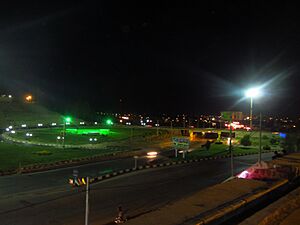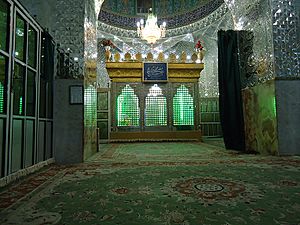Fasa facts for kids
Quick facts for kids
Fasa
Persian: فَسا
|
|
|---|---|
|
City
|
|

The northern entrance of Fasa
|
|
| Etymology: Possibly from Old Persian *pa-sāya ("encampment") | |
| Country | Iran |
| Province | Fars |
| County | Fasa |
| District | Central |
| Area | |
| • City | 25.5 km2 (9.8 sq mi) |
| Area rank | 3rd |
| Elevation | 1,150 m (3,770 ft) |
| Population
(2016)
|
|
| • Density | 4,346/km2 (11,260/sq mi) |
| • Urban | 110,825 |
| • Population Rank | 4th |
| Demonym(s) | Fasa'i |
| Time zone | UTC+3:30 (IRST) |
Fasa (Persian: فسا) is a city located in the Fars province of Iran. It is the capital of Fasa County and its Central District. In 2016, Fasa had a population of 110,825 people, making it the fourth largest city in the province.
Fasa is an ancient city, with its history going back to the Achaemenid period. Its economy mainly relies on farming and raising animals. The city is located on the main road connecting Shiraz to Kerman, which makes it an important place for trade and travel.
Contents
What's in a Name? The Etymology of Fasa
The name Fasa comes from an older form called Pasā. People have different ideas about where this name came from.
Legends and Ancient Meanings
One local story says Fasa was named after a legendary prince named Pasa. He was either the son of Fars or the grandson of Tahmuras, an ancient king. In some stories, Pasa was given the town, and in others, he built it himself.
Some experts believe the name comes from an Old Persian word, *pa-sāya, which means "campground." This suggests Fasa might have started as a camp for nomads that grew into a town. Another idea is that Fasa means "the city of the Persians." A writer from the 13th century, Yaqut al-Hamawi, even thought the name meant "the north wind."
How the Name Changed Over Time
No matter its original meaning, the name became Pasā in Middle Persian. Later, when Muslims came to Persia, the Arabic language didn't have the "P" sound. So, Arabic writers wrote the name as Fasā or Basā. Eventually, the Arabic version, Fasā, became the common name for the city.
Today, people from Fasa are called Fasā'ī.
A Look Back: The History of Fasa
Fasa has a very long history, dating back at least to the Achaemenid period, and possibly even earlier.
Early Settlements and Ancient Times
Archaeologists have found old mounds, like Tall-e Siah, which show that people lived in the Fasa area a very long time ago. One important site is Tall-e Zahhak, about 3 kilometers southeast of today's Fasa. This site was the original location of Fasa and has layers of history from 3000 BCE to the 13th century CE. At some point, the old site was left, and the name "Fasa" moved to where the city is now.
During the Achaemenid period, Fasa was an important and strong settlement. Archaeologists found a large mud-brick platform and a column base similar to those found in Persepolis. This suggests that Achaemenid Fasa might have been a royal palace or an important government center. There is also proof that people lived here during the Hellenistic period.
Fasa in the Islamic Era
Fasa came under Muslim rule peacefully in 644 CE. An Arab general made an agreement with the local leader, and the people of Fasa agreed to pay a tax for protection.
In the 10th century, Fasa was described as the biggest town in its region, almost as large as Shiraz, which was the capital of Fars province at the time. Its buildings were spacious and made of cypress wood and mud. Fasa was a wealthy town, and its people lived comfortably because of their successful trade. The city grew many different fruits and had a strong market.
A writer named Moqaddasi said in 985 CE that Fasa had "the most righteous, pleasant, and liberal people of Fars." He also noted that its marketplace was built entirely of wood, and its main mosque was even bigger than the one in Shiraz.
Challenges and Decline
Fasa faced difficult times. In 989/90 CE, the city was badly damaged during a civil war between different groups of soldiers. Later, in 1050 CE, a future Seljuk leader, Alp Arslan, raided Fasa. His forces attacked the city, causing a lot of damage and taking many captives.
After these events, Fasa is not mentioned as often in historical records, suggesting it had become less important. In the early 1100s, a writer noted that Fasa, once a great city, was mostly in ruins. However, it was later rebuilt.
In the 18th century, a leader named Karim Khan Zand moved some tribes to the Fasa area and provided them with farmland. This event likely had a big impact on the city. Later, a traveler described Fasa as a "pleasant townlet" with about two thousand houses and many villages around it.
During the Safavid period, important city buildings like the Grand Mosque and Bazaar were built or expanded. However, epidemics, famines, and conflicts caused Fasa to decline during the Qajar period.
People of Fasa: Demographics
The people of Fasa mainly speak Persian language. There is also a notable group of Khamseh Arab people living in Fasa. Almost everyone in the city is a Shia Muslim.
Population Growth
The population of Fasa has grown steadily over the years:
- In 2006, the city had 90,251 people.
- By 2011, it grew to 104,809 people.
- In 2016, the population reached 110,825 people.
| Historical population | ||
|---|---|---|
| Year | Pop. | ±% |
| 1976 | 31,489 | — |
| 1986 | 64,771 | +105.7% |
| 1991 | 74,478 | +15.0% |
| 1996 | 81,706 | +9.7% |
| 2006 | 90,251 | +10.5% |
| 2011 | 104,809 | +16.1% |
| 2016 | 110,825 | +5.7% |
Weather in Fasa: Climate
Fasa has a hot semi-arid climate. This means it has hot, dry summers and mild winters. On average, it gets about 290 millimeters (11 inches) of rain each year.
| Climate data for Fasa (1966–2010) | |||||||||||||
|---|---|---|---|---|---|---|---|---|---|---|---|---|---|
| Month | Jan | Feb | Mar | Apr | May | Jun | Jul | Aug | Sep | Oct | Nov | Dec | Year |
| Record high °C (°F) | 24.0 (75.2) |
27.0 (80.6) |
31.0 (87.8) |
39.0 (102.2) |
40.0 (104.0) |
45.0 (113.0) |
45.0 (113.0) |
43.6 (110.5) |
41.0 (105.8) |
39.0 (102.2) |
30.0 (86.0) |
28.0 (82.4) |
42 (108) |
| Mean daily maximum °C (°F) | 14.3 (57.7) |
16.8 (62.2) |
20.8 (69.4) |
26.7 (80.1) |
33.5 (92.3) |
38.3 (100.9) |
39.7 (103.5) |
38.7 (101.7) |
35.3 (95.5) |
29.8 (85.6) |
22.7 (72.9) |
16.7 (62.1) |
27.8 (82.0) |
| Daily mean °C (°F) | 7.7 (45.9) |
9.6 (49.3) |
13.2 (55.8) |
18.2 (64.8) |
24.3 (75.7) |
28.7 (83.7) |
30.6 (87.1) |
29.6 (85.3) |
25.8 (78.4) |
20.3 (68.5) |
14.1 (57.4) |
9.6 (49.3) |
19.3 (66.8) |
| Mean daily minimum °C (°F) | 1.1 (34.0) |
2.5 (36.5) |
5.6 (42.1) |
9.7 (49.5) |
15.1 (59.2) |
19.0 (66.2) |
21.6 (70.9) |
20.6 (69.1) |
16.2 (61.2) |
10.9 (51.6) |
5.6 (42.1) |
2.5 (36.5) |
10.9 (51.6) |
| Record low °C (°F) | −6.0 (21.2) |
−5.6 (21.9) |
−5.0 (23.0) |
0.0 (32.0) |
4.0 (39.2) |
10.6 (51.1) |
14.0 (57.2) |
11.0 (51.8) |
6.0 (42.8) |
2.0 (35.6) |
−2.6 (27.3) |
−7.0 (19.4) |
−7.0 (19.4) |
| Average precipitation mm (inches) | 82.3 (3.24) |
50.9 (2.00) |
52.4 (2.06) |
18.5 (0.73) |
2.1 (0.08) |
0.3 (0.01) |
1.5 (0.06) |
1.4 (0.06) |
0.3 (0.01) |
1.5 (0.06) |
13.1 (0.52) |
65.6 (2.58) |
289.9 (11.41) |
| Average relative humidity (%) | 63 | 57 | 53 | 44 | 29 | 21 | 23 | 25 | 25 | 31 | 43 | 58 | 39 |
| Average dew point °C (°F) | 0.0 (32.0) |
0.7 (33.3) |
2.7 (36.9) |
4.5 (40.1) |
4.4 (39.9) |
4.1 (39.4) |
6.7 (44.1) |
6.8 (44.2) |
3.6 (38.5) |
1.6 (34.9) |
0.4 (32.7) |
0.4 (32.7) |
3.0 (37.4) |
| Mean monthly sunshine hours | 224.5 | 221.2 | 244.9 | 262.4 | 330.9 | 351.4 | 333.8 | 325.5 | 311.4 | 301.7 | 249.3 | 224.3 | 3,381.3 |
| Source: IRIMO Fars province Meteorological Organization | |||||||||||||
Fasa's Economy
Fasa is well-known for its farming, especially for growing wheat. The good climate also helps grow many fruits like oranges, tangerines, pomegranates, pistachios, almonds, and walnuts. Cotton farming is also popular here.
Raising animals is the second most important part of Fasa's economy. The city produces various livestock, dairy products, wool, leather, and meat. There is also a large petrochemical project being built in the city, which will produce plastics when it's finished.
Local Souvenirs
The most famous souvenir from Fasa is "Fasaei bread" (Persian: نان فسایی). Other popular souvenirs include traditional rugs like Kilim, Gabbeh, and Jajim. You can also find fresh fruits like lemons, oranges, tangerines, pomegranates, walnuts, and pistachios, along with various handicrafts.
Learning and Healthcare in Fasa
Fasa has several places for learning and getting medical care.
Colleges and Universities
The city is home to several higher education institutions:
- Fasa University
- Fasa University of Medical Sciences
- Fasa Payam Noor University
- Islamic Azad University of Fasa
- Technical and Agricultural College of Fasa
Hospitals and Clinics
Fasa has hospitals and clinics to serve its residents:
- Valie Asr Hospital
- Dr. Shariati Hospital
- Emam Hossein Hospital (under construction)
Clinics:
- Valie Asr Clinic
- Hamzeh Clinic
- Yasaei Clinic
Getting Around: Transport in Fasa
Fasa has important transportation links, including roads, a railway, and an airport.
Roads
The highway connecting Fasa to Shiraz is already open. Other highway projects, like those connecting Fasa to Darab and Fasa to Estahban-Neyriz, are currently being built.
Railway
A railway line, the Shiraz-Golgohar railway, passes through Fasa. This railway aims to connect Shiraz to the Golgohar mines and Kerman province. The route is 346 kilometers long and is being built in four stages.
Airport
Fasa Airport is located near the city. It is not currently active for commercial flights, but plans are being made to improve the airport and extend its runway to restart flights. The runway is 1,982 meters long.
Places to See: Attractions and Monuments
Fasa has several interesting historical sites and natural attractions:
- Tale Zahak
- Tale Nalaki
- Imamzadeh Hasan
- Imamzadeh Qasem
- Imamzadeh Ismael
- Mianjangal Jungle
- Kharmankooh mountain
- Sassanid fire temple
- The Naghare-khane building
Images for kids
See also
 In Spanish: Fasá para niños
In Spanish: Fasá para niños




